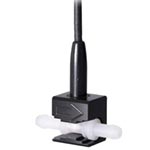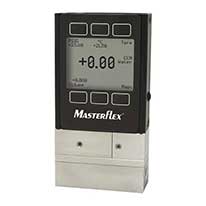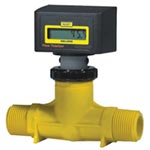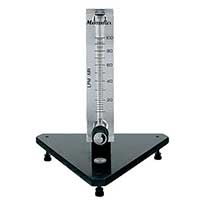Flowmeters: What Type Will Work Best for Your Application?
What Flowmeter Will Work Best for Your Application?
From single-use to magnetic to variable-area to Coriolis, the options in flowmeters are plentiful. Yet there are distinct differences in functionality, accuracy, and certainly price. Ultrasonic sensors that accurately and non-invasively measure through commonly used tubing is an excellent multi-use option that is positioned on the higher end of the price scale. If low unit price is desirable without sacrificing accuracy, then single-use turbine type sensors are a good option particularly if working fluid is low viscosity. If higher viscosity working fluids are involved, the single-use flow through disposable ultrasonic sensors are the best fit.
When selecting a flow meter consideration must be given to:
- Flow measurement type - momentum (velocity), volumetric or mass flow measurement
- Media - type of media (liquid, gas or slurry) and any special condition such as particulates in the media and viscosity of the media
- Media conditions - pressure and temperature of media and whether media conditions are likely to remain constant or vary
- Flow range - required flow range of media (min and max readings required)
- Accuracy - required accuracy of the readings
- Environmental considerations - special installation considerations such as hygienic installation, installing in to an ATEX zone or requiring tamper proof readings
Here is an overview for some of the flowmeter options available to you:

Single-Use flowmeters (Figure 1) are used in high hygiene applications such as biopharma, food, or semiconductor fabrication when a CIP option is not optimal. Sensor types include invasive sensors that come in contact with the working fluid and are discarded after each use and non-invasive models that do not come in contact with the working fluid and are therefore reusable. Given the high value placed on typical working fluids, sensor reliability, accuracy, and compatibility with the workflow are key requirements for single-use flowmeters. If extremely tight accuracies are desired, <1%, then Coriolis type flowmeters are available for single-use applications. Single-use Coriolis flowmeters are at the high end of the price scale
Coriolis Snapshot: Extremely high accuracy and no pressure drop. The meters track mass flow and offer a very high turn-down ratio. Yet initial expense is high, clogging can occur, and meters are larger in overall size.
Coriolis flowmeters offer true mass flow measurement through two designs: a single tube or two parallel tubes. They operate via an oscillation which is induced in the tube(s) at a reference frequency. Based on Newton’s Second Law of Motion (F = m x a), the oscillation frequency will change with changes in mass flow rate. Among the most accurate of technologies available, Coriolis flowmeters are suitable for a wide and growing range of gas and liquid applications. These devices provide multiparameter data on mass, density, and temperature. They are used in pharmaceutical manufacturing, wastewater treatment facilities, nuclear facilities, natural gas measurement and custody transfer.
Differential Pressure Snapshot: Very high accuracy, multiple calibrations, outputs and size. At the same time, this model can be used with water or gases only and cannot handle particulates. It also requires power.

Differential pressure flowmeters (Figure 2) measure changes in pressure to determine flow velocity. They feature a flow-restrictive orifice or laminar flow element that evaluates the pressure drop through the restriction. The pressure drop between upstream and downstream points is proportional to the rate of flow. This technology works well when no moving parts are desired, or when an ultrafast response time is required. Differential Pressure flowmeters are typically found in more industrial applications, such as measuring the output of fuels (for example, benzines or jet fuel), in specialty chemical manufacturing, simple water measurement testing, or on aquafarms. They are also used in labs to measure and control the flow of gases when mixing them or separating them through chromatography.
Gear Snapshot: High accuracy; measurement is independent of fluid viscosity. No straight pipe runs required. Accuracy degrades slightly when measuring the flow of low-viscosity fluids.
Gear meters employ oval counter-synchronized rotors (gears) which are interlocked to rotate with the passing of liquid. The amount of fluid passing through the oval gears is well controlled, giving the meters a high level of accuracy. Designs are typically rugged and simple, allowing for installation in the most aggressive environments. In fact, gear meters are one of a few types which are suited to high-viscosity fluids. Used in hydraulics and other applications involving very viscous liquids, gear flowmeters work well in the pulp and paper industry, fuel or oil transfer, and manufacturing. Because the gears are stainless steel, they are ideal for the petrochemical industry or any application incorporating light to heavy oils.
Magnetic Snapshot: No obstruction of flow path, no pressure drop, no moving parts. These meters can handle heavy slurries. Yet, the fluid measured must be conductive or water-based, and the meter must be grounded.
Magnetic meters (or magmeters) are available in two design styles: insertion and full-bore. Coils in the meter produce a magnetic field. When a conductive fluid is passed through the field, a voltage is produced through an electrode in the meter wall or insertion probe; this generated voltage is proportional to the flow. Magmeters operate by measuring the electrical content of water or other fluids. The magnetic technology contains no moving parts, and the full-bore designs offer no intrusions into the flow stream. Magmeters are higher-end flowmeters and are used in the food & beverage industry, water purification, pulp and paper manufacturing, mining, chemical manufacturing, and petrochemical industries. They should not be used with low conductivity fluids such as de-ionized water.
Paddle Wheel Snapshot: Fast response time. Easy maintenance. Inexpensive. Some may be difficult to install. Uses moving parts and requires a full pipe.

Paddle wheel meters (Figure 3) include those with rotating paddle wheels, propellers, and oscillating disks (multi-jet types). The rotating component is designed to provide a pulse when passing either a magnetic or optical sensor. The frequency of the pulses is proportional to the velocity of the fluid at one point in the pipe or channel. These designs offer relatively high accuracy for their low cost. Some insertion versions are very easy to install while other styles are more difficult. The paddle wheel style of flowmeter is often seen in rural areas for irrigation, on aquafarms, in water/wastewater treatment, and for simple water measurement. These meters are also used in utilities and the oil and gas industries and can work with viscous fluids if a turbulent flow is present.
Thermal Dispersion Snapshot: No moving parts. Measures the mass of the gas, not the volume, so it is very accurate. However, the gas must be dry and free of particulates. Response time is fairly slow.
Thermal dispersion meters operate with a side-stream flow of gas which is directed through a capillary. The capillary includes two external heater-sensor coils, one downstream from the other. Gas flow carries heat from the upstream coil to the downstream coil. The resultant temperature-dependent resistance differential at each coil is then measured. The gradient at the coils is linearly proportional to the instantaneous flow rate.
With minimal invasiveness and no moving parts, these meters are used for chemical line monitoring, purging instrument air lines, and filtration loading. They may also control the flow in gas mixing and OEM applications.
Turbine Snapshot: High accuracy, millisecond response time, along with high pressure and temperature capabilities. Conversely, their moving parts can wear or become clogged. Not for low flow.
Turbine meters contain a bladed rotor positioned along the centerline of the flow stream. The rotating component is designed to provide a pulse when passing either a magnetic or optical sensor. The frequency of the pulses is proportional to the velocity of the fluid. Some designs offer high levels of accuracy and can handle slightly higher viscosity fluids than basic propeller-type designs. Also, some turbine designs meet sanitary guidelines.
Irrigation and water purification are two common applications for turbine flowmeters. They are also used in the oil and gas, utilities, and wastewater industries. When used with sanitary connections, turbine meters control flow in food & beverage applications. These meters are not the best choice for low-flow applications.
Ultrasonic Snapshot: Very high accuracy. No pressure drops, no obstruction of flow path and no moving parts. Low maintenance costs. They are priced higher than some other technologies. Not a good choice for low-flow applications.

Ultrasonic meters (Figure 4) offer more advanced technology and greater versatility than some other types. These designs measure the frequency shift of an ultrasonic signal that is sent through the fluid. Two types of ultrasonic meters are Doppler and transit-time. Doppler technologies utilize particles or aeration in the fluid as a reflective mechanism to gauge the velocity of the fluid. Transit-time technologies rely on a frequency difference in forward and reverse signals sent though a clean liquid to gauge the velocity of the fluid; the fluid must not have solids or aeration, as they will distort the sonic pulses. These are ideal technologies to create flow profiles through an existing process, when modifying piping is not possible.
Because of their versatility, ultrasonic flowmeters are used in a long list of industries, including facilities management, pulp and paper manufacturing, chemical manufacturing, and mining. Water/wastewater, petrochemical, and aquafarms also enlist this technology. Ultrasonic meters can be used to measure the corrosiveness of slurry fluid flow.
Variable Area Snapshot: Easy setup and use with low setup cost. Very low maintenance. Can be used for both liquids and gases. Yet, these meters provide low accuracy and may not withstand caustic media. No data output or recording capabilities.

Variable Area flowmeters (Figure 5) are the veterans in the industry and are the most commonly used. They are also referred to as rotameters. Their design consists of a float—usually a sphere—enclosed in a tube. The float responds to change in velocity of the fluid (gas, air, or liquid) by moving up or down the flow tube. The variable area principle of operation is: fluid flow velocity raises a float in a tapered tube, increasing the area for passage of the fluid. The greater the flow, the higher the float rises. The height of the float is directly proportional to the flow rate. To determine flow, simply read thegraduated markings at the center of the float.
Variable area flowmeters can be used in laboratory and industrial applications, and when compared with other types of flow instrumentation, are the most economical for indicating flow rate measurement when taking into account practicality and accuracy. These meters are used in academia in science labs for experimentation and education. They can be found in basic manufacturing including beverage manufacturing and chemical manufacturing as well as in water purification, aquafarms, and oil and gas applications. These meters should not be used with media that could coat the float or measuring tube.
Vortex Snapshot: Low to medium initial setup costs. Very low maintenance when used in clean flow conditions. Yet, the vortex meters may experience a low to medium pressure drop due to an obstruction in the flow path.
Vortex meters use a pressure sensor to measure the pressure pulses from vortices that come from the fluid passing a bluff body bar across the flow stream. A simple analogy of this phenomenon is that of a flag waving in the wind. The pulses are proportional to the rate of flow. Many users find the technology appealing because it has no moving parts and a low sensitivity to variations in process conditions.
Although many may be less familiar with the vortex flowmeter, it is an option that offers high accuracy. Because the meter body and vortex bar can be molded as one, the design is ideal for use in either aggressive or high-purity applications. These meters work well in the oil and gas, water/wastewater, and food & beverage industries. They are also used in utilities, chemical manufacturing and water purification.
For additional application guidance, you can refer to the flowmeter selection table below:
| Application parameter | Gases | Liquids | Flowmeter type |
|---|---|---|---|
| Non-invasive high hygiene process such as biopharma 30 mL/min to 100 L/min | • | Ultrasonic | |
| Single-use disposable high hygiene process such as biopharma 30 mL/min to 100 L/min |
• • |
Ultrasonic Turbine |
|
| Low-flow measurement/control (some types as low as 1 sccm air and 0.1 mL/min water, max of range) | • • • • • • • • |
• • • • • • • • • • • |
Gas mass Coriolis Differential pressure Indicators/switches Turbine Variable area Pelton wheel Vortex Gear Paddle wheel Magnetic Ultrasonic |
| High-flow measurement/control (some types as high as 2300 scfm gas and 2600 GPM liquid) | • • • • • • • |
• • • • • • • • • • |
Gas mass Coriolis Differential pressure Indicators/switches Variable area Pelton wheel Vortex Paddle wheel Magnetic Turbine Ultrasonic |
| High pressure (500 psi and up) |
• • • • |
• • • • • • |
Gas mass Coriolis Switches Variable area Gear Turbine Ultrasonic |
| High temperature (200°F and up) | • • • • |
• • • • • • • • • |
Coriolis Differential pressure Vortex (including steam) Variable area Ultrasonic Turbine Magnetic Paddle wheel Gear |
| High-accuracy measurement (error at or below 1%) | • • • • • |
• • • • • • • • |
Differential pressure Pelton wheel Gas mass Coriolis Vortex Gear Paddle wheel Magnetic Turbine Ultrasonic |
| Aggressive or pure fluids | • • • • |
• • • • • • • • |
Gas mass Turbine Switches Variable area Gear Paddle wheel Magnetic Ultrasonic Vortex |
| Fluids with heavy particulates or slurries | • |
• • • |
Coriolis Magnetic Ultrasonic |
| High-viscosity fluids | • |
• • • |
Coriolis Gear Magnetic |
| No wired power available | • • • • • |
• • • • • • |
Differential pressure Flow Indicators Turbine Variable area Gear Paddle wheel Ultrasonic |
| Intrinsically safe | • | • • |
Variable area Turbine |
| Large pipe sizes (3" or larger) |
• | • • • • |
Coriolis Ultrasonic Magnetic Paddle wheel |
| Sanitary (meets 3A standards) |
• • |
Turbine Magnetic |